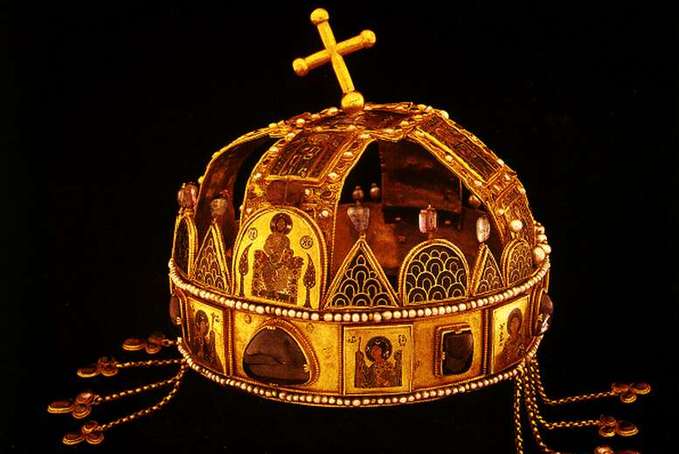The question is, which of our present-day coronation badges, apart from the holy crown, are undoubtedly of St. Stephen's age?
The cloak, and maybe even the scepter. Because the sword, country apple, and other clothes, even the cross, which are still used today, are undoubtedly later , and the style of most of them already reveals this. However, the mantle - which is the work of Queen Gizella and her ladies-in-waiting - is embroidered on it, and despite the many repairs and alterations, it can still be read today that it was presented by Queen Gizella to the church in Veszprém. This suit, originally made as a mass dress, was transformed into the coronation robe.
The scepter appears to be from the time of Saint Stephen - its style points to this - and it is one of the oldest surviving European royal sceptres, if not the oldest. However, due to the lack of data, it cannot be traced back to St. István with complete certainty, since despite its antiquity, it could have been included in the Hungarian coronation badges later. The sword is a late piece, around the 16th century. century, the national apple, the age of which is revealed by the Hungarian coat of arms from the Anjou period, is also later, and the apostolic cross is also later , which in its present form could not be found among the insignia of Saint Stephen.
But let us now see the further fate of the Hungarian Holy Crown. We know that our present-day Saint's crown is joined in two parts , namely in a rather primitive way: the upper part, Saint Stephen , is nailed with 1·5 mm thick gold nails to the lower Byzantine crown of Géza I.
Such an important event has never occurred in the rather tumultuous history of our Holy Crown. During the unfortunate fraternal wars of the Árpáds, he migrated a lot from one claimant to the throne to another, but we don't know anything worth mentioning about him until the well-known adventure of Otto Bajor the Holy Crown, which he had received from his predecessor, the abdicated Wenceslas, somewhere in Austria, on a well-traveled country road, while traveling to Hungary, when he was elected king of Hungary in 1305 As you know, the Holy Crown hidden in the case - perhaps the case is faithfully represented by the picture of the Képes Krónika capturing this scene - fell from the car in which Otto was traveling, and it was not found until much later by Otto's men sent back to look for it. The religious imagination of the time, which was deeply influenced by the belief in God's all-encompassing care, saw the work of Divine Providence in the miraculous finding of the Holy Crown, and explains it by the fact that God did not want Hungary to be deprived of the crown of his angel- envoy.
So the holder of the Holy Crown is already here, in the XIV. In the Képes Chronicle of the middle of the 20th century, it is Hungary, and not the king. From the beginning, Ottó was unable to strengthen his weak and unpopular rule, and therefore, in order to win the alliance of the powerful László Apor , he wanted to marry his daughter. However, the voivode captured the royal suitor and took the Holy Crown for himself. Ottó was soon freed, but having lost hope, he gave up the fight to win the Hungarian throne and left the country. The Holy Crown remained with Apor, who refused to hand it over to Róbert Károly, who had ascended the throne in the meantime. Károly was therefore crowned with another Gentilis , in 1309, while the original Holy Crown was cursed by Gentilis, so that it could not be validly crowned until it was given to Róbert Károly, or until it was in the possession of the Székesfehérvár chapter. costs The latter has been the guardian of the Holy Crown until now.
Finally, László Apor issued the Holy Crown in 1310, and Károly could be crowned with it at his last: fourth Hungarian coronation. From then on, the Holy Crown was kept within the time-defying walls of the secure Visegrád Castle, or else in Buda, in the royal castle. But the royal butler's house in Buda was also the place where our Holy Crown was kept. The strange event that happened to our Holy Crown in Visegrád Castle in 1440, which has already been mentioned several times, is very typical of the infinitely great importance of the crown: the abduction of the Holy Crown on the orders of the Dowager Queen Mother Elizabeth. We also mentioned that the reprehensible order of the queen was carried out by Ilona Kottaner Although the adventurous robbery story and the exciting journey from Visegrád to Komárom to the queen, in a wagon during the winter flood, across the ice of the frozen Danube, which cracked under the weight of the wagon carrying the Holy Crown, we cannot tell it again here. Here, only that when Erzsébet found out that the lords of her party were willing to crown her child, at first she did not dare to confess her crime in front of the Hungarian lords, but regretting her act, which proved to be unnecessary, she wanted to persuade Ilona Kottaner to smuggle back the crown. again to Visegrád. However, the poor woman, who had already endured a great deal of anxiety, physical and mental pain, and pangs of conscience because of her crime, could not be persuaded to do so in any way, and forgetting her respect and subordination to the queen, she refused to fulfill the even stranger commission in a rather blunt response. . But the Dowager Queen Mother was not angry.
They decided to carry out the coronation right away, and King Ilona Zsigmond of Kottaner sewed little László's coronation suit in great secrecy from an ornate, gold and red, white patterned suit, which was later transformed into a mass dress, at night in the chapel of the Komárom castle. white shirt), mantle, stole (so this was also among the coronation clothes, which shows that the coronation dress corresponds to almost a full priestly regalia), bracelet (as for the priest celebrating mass), gloves (abbots and bishops also wear this in full decorated) and saru. This description is very important, as the only and completely authentic list of what pieces the Hungarian king's coronation outfit consisted of. (Here I can remind you of the well-known portrait of Emperor Sigismund painted by Dürer, which also has a stole and bracelets, and the emperor is depicted almost as a bishop celebrating mass.)
After these preparations, the Dowager Queen Mother confessed to the Hungarian lords that she already had the Holy Crown. Seeing the bad impression that this discovery on László Garai , the baron entrusted with guarding the Holy Crown, (from this it seems that he really did not know about the theft of the Holy Crown) he called on Cillei Ulrik's other relative, Prince Albert of Austria, . The Austrian prince realized the situation: if the Polish king Ulászló ascends the Hungarian throne, the hopes of the Habsburg house to win the Hungarian throne will be lost, while the Austrian house will have bright opportunities from the seizure of the throne by the child László. In the death of a horse - in the strict sense of the word, because he chased several horses to death - he was born in Székesfejérvár, on the very day of Pentecost, on which the crowning of the little one was scheduled. We have already described the sudden coronation, at which only a part of the Hungarian citizens appeared, the rest - the larger and more significant part, including János Hunyadi stood by the most suitable king candidate against the Turkish threat: Ulászló I.
Our Holy Crown XV. The ordeal of the 19th century did not end with the assassination of Ilona Kottaner, in fact the most serious part of it had only just begun. After the coronation of the child László on Pentecost (May 15, 1440) - this is also quite well known - our Holy Crown remained in the hands of the dowager queen, who guarded it jealously and refused to hand it over to Ulászló I, who had also been crowned in the meantime.












